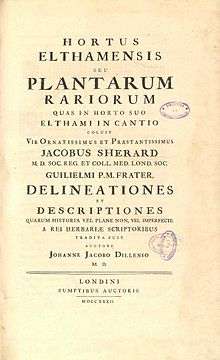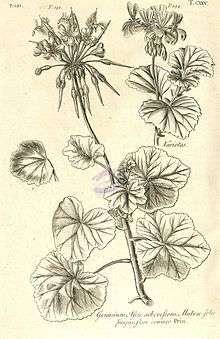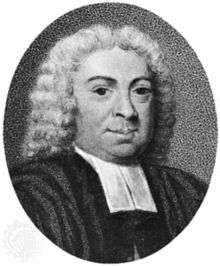Johann Jacob Dillenius
Johann Jacob Dillen Dillenius (1684–2 April 1747) was a German botanist.


Johann Jacob Dillenius | |
|---|---|
 Johann Jacob Dillenius | |
| Born | 1684 |
| Died | 2 April 1747 |
| Nationality | German |
| Alma mater | University of Giessen |
| Scientific career | |
| Fields | |
| Institutions | Oxford University |
| Author abbrev. (botany) | Dill. |
Biography
Dillenius was born at Darmstadt and was educated at the University of Giessen, earlier the family name had been changed from Dillen to Dillenius. In 1721, at the instance of the botanist William Sherard, he moved to England. In 1734 Dillenius was appointed Sherardian professor of botany at Oxford, in accordance with the will of Sherard, who at his death in 1728 left the university £3000 for the endowment of the chair, as well as his library and herbarium,[1] all on the condition that Dillenius should be appointed the first professor.[2]
Dillenius died at Oxford, of apoplexy. His manuscripts, books and collections of dried plants, with many drawings, were bought by his successor at Oxford, Dr. Humphry Sibthorp (1713–1797), and ultimately passed into the possession of Oxford University. For an account of his collections preserved at Oxford, see The Dillenian Herbaria, by G. Claridge Druce (Oxford, 1907).[1]
Work
At Giessen Dillenius wrote botanical papers for the Ephemerides naturae curiosorum. He printed, in 1719, his flora of the university's surroundings, a Catalogus plantarum sponte circa Gissam nascentium, which was illustrated with figures drawn and engraved by his own hand, and contained descriptions of new species.[1]
In 1724 Dillenius published the third edition of John Ray's Synopsis Methodica Stirpium Britannicarum. It incorporated plant species discovered by Samuel Brewer, and work on mosses by Adam Buddle.[3][4] It remained a standard reference for British botanists until the appearance of Carl Linnaeus' Species Plantarum in 1761.
In 1732 he published Hortus Elthamensis,[5] a catalogue of the rare plants growing at Eltham, London, in the collection of Sherard's younger brother, James (1666—1738), who, after making a fortune as an apothecary, devoted himself to gardening and music. For this work Dillenius himself executed 324 plates; it was described by Linnaeus, who spent a month with him at Oxford in 1736, and afterwards dedicated his Critica Botanica to him, as opus botanicum quo absolutius mundus non vidit, "a botanical work of which the world has not seen one more authoritative". Further, Linnaeus would later name a genus of tropical tree Dillenia in his honor.[1]
Dillenius was also the author of a natural history of mosses, Historia muscorum (1741), which also covered liverworts and hornworts.[6] He acknowledged the help with it he had from George Charles Deering. They had met at John Martyn's club for botanists, and also studied fungi together.[7][8]
Selected publications
- Dillenius, Johann Jakob (1732). Hortus Elthamensis, seu Plantarum rariorum, quas in horto suo Elthami in Cantio coluit ... Jacobus Sherard ... Guilielmi ... frater delineationes et descriptiones. London: Sumptibus auctoris. Retrieved 26 July 2015.CS1 maint: ref=harv (link)
- Ray, John (1724) [1690]. Dillenius, Johann Jacob (ed.). Synopsis methodica stirpium Britannicarum: in qua tum notae generum characteristicae traduntur, tum species singulae breviter describuntur: ducentae quinquaginta plus minus novae species partim suis locis inseruntur, partim in appendice seorsim exhibentur: cum indice & virium epitome (editio tertia multis locis emendata, & quadringentis quinquaginta circiter speciebus noviter detectis aucta ) [Synopsis of British plants] (in Latin) (3rd ed.). London: Gulielmi & Joaniis Innys.
- Facsimile edition 1973, Ray Society, London. With introduction by William T. Stearn. ISBN 978-0-903874-00-7
References
-

- Stephen, Leslie, ed. (1888). . Dictionary of National Biography. 15. London: Smith, Elder & Co. p. 79.
- Martin, John. "Brewer, Samuel". Oxford Dictionary of National Biography (online ed.). Oxford University Press. doi:10.1093/ref:odnb/3366. (Subscription or UK public library membership required.)
- Browne, Janet. "Buddle, Adam". Oxford Dictionary of National Biography (online ed.). Oxford University Press. doi:10.1093/ref:odnb/3883. (Subscription or UK public library membership required.)
- Dillenius 1732.
- David L. Hawksworth (26 June 2003). The Changing Wildlife of Great Britain and Ireland. CRC Press. p. 78. ISBN 978-0-415-32681-0.
- Allen, D. E. "Deering, George Charles". Oxford Dictionary of National Biography (online ed.). Oxford University Press. doi:10.1093/ref:odnb/7419. (Subscription or UK public library membership required.)
- Mabberley, D. J. "Dillenius, Johann Jakob". Oxford Dictionary of National Biography (online ed.). Oxford University Press. doi:10.1093/ref:odnb/7648. (Subscription or UK public library membership required.)
- IPNI. Dill.